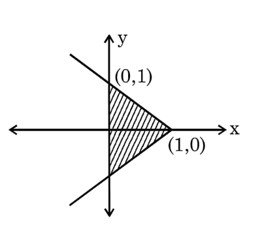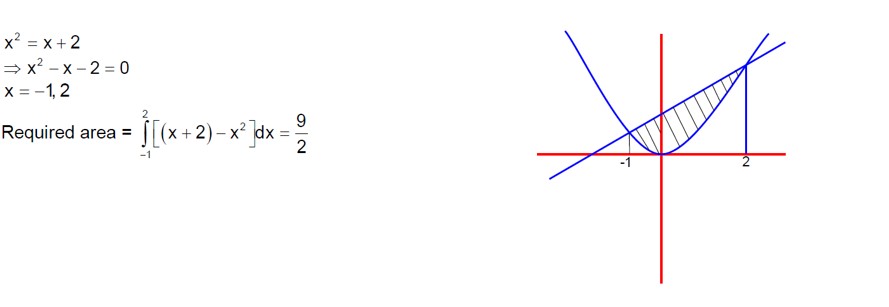Maths Application of Integrals
Get insights from 29 questions on Maths Application of Integrals, answered by students, alumni, and experts. You may also ask and answer any question you like about Maths Application of Integrals
Follow Ask QuestionQuestions
Discussions
Active Users
Followers
New answer posted
2 months agoContributor-Level 10
y = |x − 1|, y = 3 – |x|
(A graph is shown with vertices A (1, 0), B (2, 1), C (0, 3), D (-1, 2). The lines are y = x - 1, y = 3 - x, y = 3 + x, and y = -x + 1)
AB = √2, BC = 2√2
⇒ Area = 4 sq. units
New answer posted
2 months agoContributor-Level 10
Required area (above x-axis)
A? = 2∫? (8/2 - x - √x)dx
= 2 [16 - 16/4 - 8/3*2] = 40/3
and A? = 4 (1/2 k²) = 2k²
∴ 27 * (40/3) = 5 * (2k²)
=> k = 6
for above x-axis.
New answer posted
2 months agoContributor-Level 10
Area A = 2π - ∫? ¹ (√x - x) dx is incorrect. The area is likely between two curves.
The calculation shown is:
A = 2π - [2/3 x^ (3/2) - x²/2] from 0 to 1.
A = 2π - (2/3 - 1/2) = 2π - (4/6 - 3/6) = 2π - 1/6 = (12π - 1)/6.
New question posted
2 months agoNew answer posted
2 months agoContributor-Level 10
We are given bounds for a function f (t) on two intervals and need to find the range of g (3) = ∫? ³ f (t) dt.
We split the integral: g (3) = ∫? ¹ f (t)dt + ∫? ³ f (t)dt.
For the first interval t ∈ [0, 1], we have 1/3 ≤ f (t) ≤ 1. Integrating from 0 to 1 gives:
∫? ¹ (1/3) dt ≤ ∫? ¹ f (t)dt ≤ ∫? ¹ 1 dt ⇒ 1/3 ≤ ∫? ¹ f (t)dt ≤ 1.
For the second interval t ∈ (1, 3], we have 0 ≤ f (t) ≤ 1/2. Integrating from 1 to 3 gives:
∫? ³ 0 dt ≤ ∫? ³ f (t)dt ≤ ∫? ³ (1/2) dt ⇒ 0 ≤ ∫? ³ f (t)dt ≤ (1/2) (3-1) = 1.
Adding the inequalities for the two parts of the integral:
1/3 + 0 ≤ g (3) ≤ 1
New answer posted
2 months agoContributor-Level 10
The numbers 1, log10(4^x - 2), and log10(4^x + 18/5) are in an Arithmetic Progression (A.P.).
This means that the corresponding numbers 10^1, 10^(log10(4^x - 2)), and 10^(log10(4^x + 18/5)) are in a Geometric Progression (G.P.).
So, 10, 4^x - 2, and 4^x + 18/5 are in G.P.
For a G.P., the square of the middle term is equal to the product of the other two terms:
(4^x - 2)^2 = 10 * (4^x + 18/5)
Let y = 4^x.
(y - 2)^2 = 10y + 36
y^2 - 4y + 4 = 10y + 36
y^2 - 14y - 32 = 0
(y - 16)(y + 2) = 0
So, y = 16 or y = -2.
Since y = 4^x, y must be positive. Thus, 4^x = 16, which gives x = 2.
The determinant calculation that follows appears to be unrelated to the
New answer posted
2 months agoContributor-Level 10
Limit (n→∞) [[r] + [2r] + . + [nr]] / n²
We know that x - 1 < [x] x.
Summing from k=1 to n for [kr]:
Σ(kr - 1) < [kr] (kr)
rΣk - Σ1 < [kr] rk
r(n(n+1)/2) - n < [kr] r(n(n+1)/2)
Divide by n²:
(r/2)(1 + 1/n) - 1/n < ([kr])/n (r/2)(1 + 1/n)
As n → ∞, both the left and right sides approach r/2.
By the Squeeze Theorem, the limit is r/2.
New answer posted
2 months agoContributor-Level 9
Given curves are y = x² - 1 and y = 1 - x² so intersection points are (±1,0). Bounded area =
4∫? ¹ (1 - x²)dx = 4 [x - x³/3]? ¹
= 4 (1 - 1/3) = 8/3 sq. units
Taking an Exam? Selecting a College?
Get authentic answers from experts, students and alumni that you won't find anywhere else
Sign Up on ShikshaOn Shiksha, get access to
- 65k Colleges
- 1.2k Exams
- 678k Reviews
- 1800k Answers


